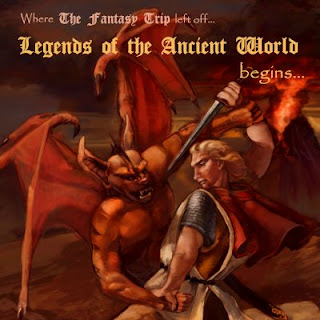Monday, August 30, 2010
Anybody Wanna Trade For In The Labyrinth?
Sunday, August 29, 2010
TFT Adventure: The Crown Of Kings
Dark City Games resurrected The Fantasy Trip rules in 2005, by creating a free retro-clone called Legends of the Ancient World (LotAW). In addition to a fantasy ruleset, two other free rulesets, for science fiction and western adventures, are also available on the DCG website.
Publishing those retro-clone rules allowed Dark City Games to release 19 new MicroQuest adventures, compatible with LotAW.
According to the lore of DCG, The Crown Of Kings adventure was originally submitted to Metagaming some 30 years ago, just as Metagaming was imploding. The Dew brothers, George and Warren, created DCG and LotAW in 2005 in order to publish this, and other adventures, and keep the spirit of The Fantasy Trip alive.
The Crown Of Kings was published in 2005. It is priced at $12.95, and consists of a 44-page booklet, a sheet of cardboard counters representing the characters, monsters and opponents in the adventure, and a playing board used for encounters. The adventure consists of almost 600 paragraph entries, with the players moving from paragraph to paragraph, based on the choices they make at the end of each entry.
The premise of The Crown Of Kings is fairly straightforward. The players have heard rumor that a local warlord is in possession of the legendary Crown of Kings. They decide to break into his castle to steal it.
I must confess, when I read the premise of the adventure, I was hopeful. Surely the Crown of Kings is not simply a crown, I thought, just as the Sphere Of Power from the D&D adventure, The Lost Tomb Of Martek, was something other than a crystal ball. I imagined that the adventure would end with the Players a little wiser, but no richer, having discovered that not all legends are to be taken literally.
Unfortunately, the Crown Of Kings really is a crown, and a magic item to boot. While the adventure is reasonably well written, and features art by
If you are interested in some light role-playing, or would like to discover what The Fantasy Trip was all about, you may enjoy giving LotAW a chance. DCG has four free adventures available from the website, as well as the free rules. For those who have played some or all of the original MicroQuests, you may want to give The Crown Of Kings or some of the other DCG adventures a try. While this particular adventure seems a little overpriced, at $12.95, some of the other adventures, such as The Dark Vale, are well worth it.
Wednesday, August 25, 2010
The Fantasy Trip Retroclone

Tuesday, August 24, 2010
I'm A Wealthy, Wealthy Man ...
G.E.V. ... $30
Monday, August 23, 2010
LotFP Weird Fantasy RPG: Rules Review
Sunday, August 15, 2010
Lamentations Of The Flame Princess: Weird Fantasy Role-Playing
The addition of a Tutorial booklet is an interesting feature of Weird RPG. It assumes that the game will be marketed to and purchased by those unfamiliar with, or uninitiated into, the world of paper and pencil role playing games. I applaud James' optimism, and hope that Weird RPG does indeed attract new players to the traditional PnP RPG hobby. But this Tutorial booklet is also valuable to those of us who are already well-acquainted with RPGs, as it provides some interesting insight into how James sees the role-playing game process occurring.
Another pleasant surprise: James' version of Appendix N, entitled "recommended reading." Among those appearing on James' list of recommended authors are Clive Barker, Robert E. Howard, Fritz Leiber, H.P. Lovecraft, Edgar Allan Poe, Clark Ashton Smith, J.R.R. Tolkien, Jack Vance, Jules Verne, and H.G. Wells. Each author receives a detailed biography by a guest biographer.
I can honestly say that this is the closest anyone has come to publishing my dream old-school boxed set. Once I have a chance to delve deeper into the Weird RPG booklets and supplementary material, I will provide some additional comments.